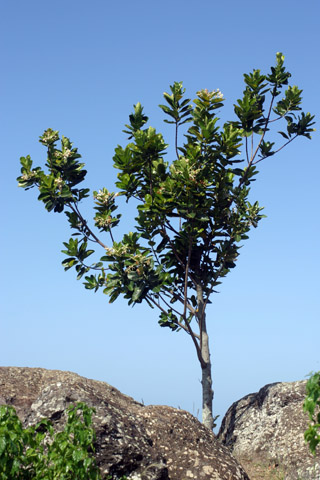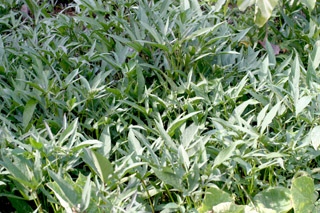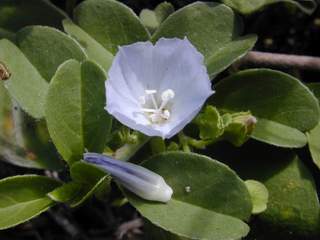Family CLUSIACEAE

Kamani
NOTES: Many young trees were planted initially, but few survived their first dry season. This one (left) planted on Pu‘u Pōhaku did survive and has grown rapidly where once a Java plum stood. Despite the somewhat unlikely location (growing from a crack in the main pōhaku) , this tree was first noted flowering in early 2008 and by late 2009 was producing much fruit. Seedlings now appear scattered downslope from the original planting (2014-5).
Population: 4 (12/13)
Family CONVOLVULACEAE

‘uala
NOTES: Persists, spreading by vegetative growth. Dies out if shaded. ‘uala is used as a ground cover in open areas, surviving the dry season then spreading rapidly in the wet season. We have 2 or three varieties planted at Nā Pōhaku o Hauwahine, and 'piko' seems to do the best through the dry season. [open areas].
Population: TNTC (09/15); 2 (05/18)

Pā‘ū o Hi‘iaka
NOTES: Persists, spreading by vegetative growth; sometimes seeding. Dies out if shaded by shrubs or trees. This species was our most prolific ground cover in open areas, surviving the dry season then spreading rapidly in the wet season. These areas of dense cover have now disappeared (typically either shaded by shrubs or covered by pili). However, pā‘ū o Hi‘iaka persists much like it occurs elsewhere in nature: as isolated strands in open areas between other plants. No gray-green (hairy) forms occur naturally at Nā Pōhaku o Hauwahine; those that have been planted, tend not to persist. Appears spontaneously in native planted areas. [open areas, xeric to mesic].
Population: not seen (12/13); 1 (09/15); 3 (05/18)